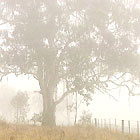Every week, parts of Burke’s Backyard are filmed in Don’s garden. It is a native garden, which includes many plants that are indigenous (that is local) to the area. Over 200 species of birds visit the garden throughout the year, including silver eyes, finches, lorikeets, crimson rosellas and black cockatoos. Native plants, such as bottlebrushes, banksias, kangaroo paws, grevilleas and eucalypts, provide the birds with both food and a habitat, and shrubs that flower during autumn and winter are particularly important for the nectar feeding birds.
Don’s tip: when designing your garden, include plenty of local native shrubs. If you just plant trees and grass you’ll attract birds like noisy miners, which chase other birds away.
Further information
You can obtain advice on suitable bird attracting plants for your climate and conditions at a specialist native plant nursery, for example:
NSW
Annangrove Grevilleas Native Nursery, Kenthurst. Phone: (02) 9654 1380
Cranebrook Native Nursery, Cranebrook. Phone: (02) 4777 4256
Sydney Wildflower Nursery West, Marsden Park. Phone: (02) 9628 4448
Sydney Wildflower Nursery South, Heathcote. Phone: (02) 9548 2818
Palm Land and Sydney Wildflower Nursery. Phone: (02) 9450 1555
QLD
Fairhill Native Plants, Yandina. Phone: (07) 5446 7088
Nielsen’s Native Nursery, Loganholme. Phone: (07) 3806 1414
VIC
Kuranga Native Nursery, Ringwood. Phone: (03) 9879 4076
Mt Cassell Native Nursery, Pomonal. Phone: (03) 5356 6351
SA
Nellie Nursery, Mannum. Phone: (08) 8569 1762
WA
Zanthorrea Nursery, Maida Vale. Phone: (08) 9454 6260
Lawn damage
Many viewers have written to Burke’s Backyard to say that their lawns and plants have been damaged by frost. Don explained that it’s the thaw, rather than the frost, that causes the problem. Some areas of Australia have been experiencing clear, cold nights followed by warm, sunny days. Plant cells are damaged when they warm up very rapidly after a cold, frosty night.



